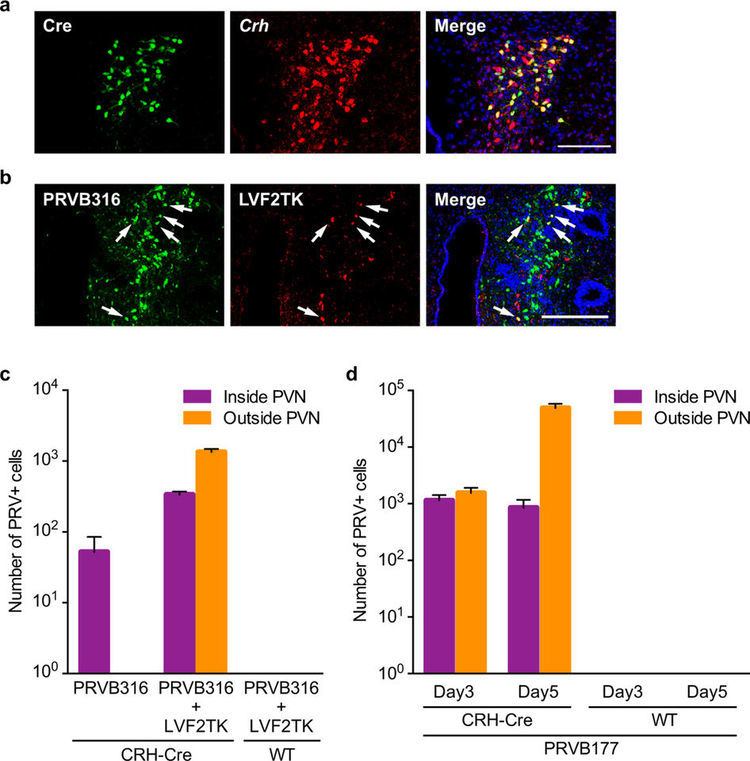Entrez 1392 | Ensembl ENSG00000147571 | |
 | ||
External IDs OMIM: 122560 MGI: 88496 HomoloGene: 599 GeneCards: CRH | ||
Corticotropin releasing hormone
Corticotropin-releasing hormone (CRH) also known as corticotropin-releasing factor (CRF) or corticoliberin is a peptide hormone involved in the stress response. It is a releasing hormone that belongs to corticotropin-releasing factor family. In humans, it is encoded by the CRH gene.
Contents
- Corticotropin releasing hormone
- Hormonal actions
- Psychopharmacology
- Role in parturition
- Structure
- Role in non mammalian vertebrates
- Interactions
- References
Its main function is the stimulation of the pituitary synthesis of ACTH, as part of the HPA Axis.
Corticotropin-releasing hormone (CRH) is a 41-amino acid peptide derived from a 196-amino acid preprohormone. CRH is secreted by the paraventricular nucleus (PVN) of the hypothalamus in response to stress. Increased CRH production has been observed to be associated with Alzheimer's disease and major depression, and autosomal recessive hypothalamic corticotropin deficiency has multiple and potentially fatal metabolic consequences including hypoglycemia. In addition to being produced in the hypothalamus, CRH is also synthesized in peripheral tissues, such as T lymphocytes, and is highly expressed in the placenta. In the placenta, CRH is a marker that determines the length of gestation and the timing of parturition and delivery. A rapid increase in circulating levels of CRH occurs at the onset of parturition, suggesting that, in addition to its metabolic functions, CRH may act as a trigger for parturition.
A recombinant version for diagnostics is called corticorelin (INN).
Corticotropin releasing hormone
Hormonal actions
CRH is produced by parvocellular neuroendocrine cells within the paraventricular nucleus of the hypothalamus and is released at the median eminence from neurosecretory terminals of these neurons into the primary capillary plexus of the hypothalamo-hypophyseal portal system. The portal system carries the CRH to the anterior lobe of the pituitary, where it stimulates corticotropes to secrete adrenocorticotropic hormone (ACTH) and other biologically-active substances (β-endorphin). ACTH stimulates the synthesis of cortisol, glucocorticoids, mineralocorticoids and DHEA.
In the short term, CRH can suppress appetite, increase subjective feelings of anxiety, and perform other functions like boosting attention. Although the distal action of CRH is immunosuppression via the action of cortisol, CRH itself can actually heighten inflammation, a process being investigated in multiple sclerosis research.
Psychopharmacology
The CRH-1 receptor antagonist pexacerfont is currently under investigation for the treatment of generalized anxiety disorder. Another CRH-1 antagonist antalarmin has been researched in animal studies for the treatment of anxiety, depression and other conditions, but no human trials with this compound have been carried out.
Also, abnormally high levels of CRH have been found in the cerebrospinal fluid of people that have committed suicide.
Recent research has linked the activation of the CRH1 receptor with the euphoric feelings that accompany alcohol consumption. A CRH1 receptor antagonist developed by Pfizer, CP-154,526 is under investigation for the potential treatment of alcoholism.
Alpha-helical CRH-(9–41) acts as a CRH antagonist.
Role in parturition
CRH is also synthesized by the placenta and seems to determine the duration of pregnancy.
Levels rise towards the end of pregnancy just before birth and current theory suggests three roles of CRH in parturition:
In culture, trophoblast CRH is inhibited by progesterone, which remains high throughout pregnancy. Its release is stimulated by glucocorticoids and catecholamines, which increase prior to parturition lifting this progesterone block.
Structure
The 41-amino acid sequence of CRH was first discovered in sheep by Vale et al. in 1981. Its full sequence is:
The rat and human peptides are identical and differ from the ovine sequence only by 7 amino acids.
Role in non-mammalian vertebrates
In mammals, studies suggest that CRH has no significant thyrotropic effect. However, in representatives of all non-mammalian vertebrates, it has been found that, in addition to its corticotropic function, CRH has a potent thyrotropic function, acting with TRH to control the thyroid axis (TRH has been found to be less potent than CRH in some species).
Interactions
Corticotropin-releasing hormone has been shown to interact with corticotropin-releasing hormone receptor 1.
